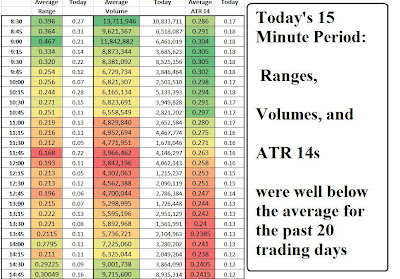
Yes, Thank Goodness It's
NOT Friday. Why do I not like Fridays? Most traders dislike Friday because they know they have to wait through the weekend for the markets to open back up. While I feel this way as well, there is a much better reason that I don't like Fridays..at least when it comes to trading.
I cannot stand to have a bad Friday tradingwise because then you get the whole weekend to stew over your mistakes and what you should or should not have done. This is not fun. I had a bad trading day this past Friday. After the market closed, I was writing in my trading journal and doing other end of day activities related to trading when it hit me...I did not have a good Friday last week either. And then I checked my trading journal and realized that I have not had a good day of trading on a Friday in at over a month, and even the good Fridays that I've had were mediocre at best!
After having this little break through, I pulled up my trading reports and looked at a report that breaks down trading performance for different times and more importantly, different days. This really put things in perspective for me. The day of the week that I have the highest win ratio (batting average) is Monday with a 60% win ratio. Not bad for the type of intra day trend style trading I do. My absolute worst day (drum roll) is the dreaded Friday with a win ratio of only 28%..ouch.
So what does this tell me? Either to not trade at all on Fridays or at the very least, reduce my trading to a little while in the morning and keep very tight risk control measures...like quit for the day after 2 losing trades or 2 winning trades. So why are Fridays so bad? I don't really know but I have a few ideas that pertain specifically to me..it will be different for everyone I'm sure.
For one, after having had a bad Friday once and thinking about it all weekend, I began going into Fridays thinking, "don't have a bad Friday, don't have a bad Friday." It's funny how when we tell ourselves not to do something or that we don't want such and such to happen, we either do it or whatever it is happens. A weird phenomenon that some chalk up to the subconscious and it's inability to comprehend the negative phrasing. Thus, we say, "don't do such and such" but our subconscious only hears "do such and such." So this could be a factor explaining bad Fridays and it is also the reason that positive self talk is so important.
Furthermore, I tend to go into Fridays with the mind set of, "it's the last trading day of the week, better make some money." This tends to screw up my open mindedness with trading as I'm now expecting something from the market that may or may not happen. Having expectations that don't match up with the market in trading can lead to a disaster, especially if you're stuck in your expectations and fail to change your trading based on what is unfolding in front of you through out the trading day. Every dip in an uptrend begins to look like a buyable dip and the thought never crosses your mind that this could be the end or even a late day reversal. You stop looking for or even ignoring evidence that supports or conflicts with your ideas. As you can imagine, this is not a profitable trading mindset.
Then note that Mondays for me tend to be the opposite. I'm refreshed, open minded and ready to see what the market is going to offer for the new week. This leads to great trading days. Imagine that. It doesn't take a genious in psychology to figure this stuff out but it does take a discplined trader that is both open and willing to change in order to take the necessary action involved to improve on these problems. As for me and my discipline and willingness, we'll give it a little time and then I'll do a follow up post on my progress or lack thereof.
Okay, that's enough for one post..I didn't mean to sit down and write a book, I just needed to get all of this down in written form.
I hope eveyone's having a great weekend.
TLT
 Gameplan:
Gameplan:











